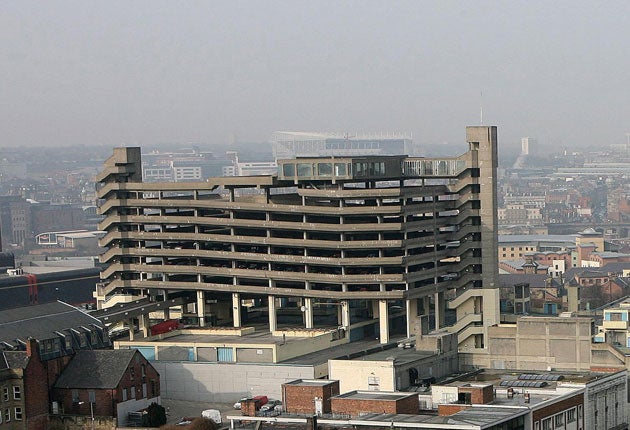Mike Hodges: A concrete monstrosity, but it was perfect for my film
As the brutalist Gateshead car park made famous by the Seventies gangster classic 'Get Carter' is demolished, the film's director looks back on a location that won the hearts of film buffs, if not the locals

One contemporary phenomenon is the almost mystical status paid to locations used in films and television. Many have become places of pilgrimage. I must take responsibility for one such place – the car park owned by the property developer Cliff Brumby, one of many villains in my 1971 film Get Carter. Whilst most of the locations featured in the film have long since been demolished, the Trinity Centre in Gateshead has survived. Until today. This morning it will meet the wrecking ball.
The novel from which I adapted the script (Jack's Return Home by Ted Lewis) didn't specify the town in which the story unfolds so I felt free to set it in Newcastle. A decade earlier during my National Service I'd sailed into the mouth of the Tyne on a fishery protection minesweeper and witnessed the poverty and deprivation so vividly described in Ted's novel. The fishing quays and the big ships alongside the shipyards made a huge impression on my young mind.
Having drafted the script I spent weeks combing the area for locations. That's when I saw the Trinity Centre. You couldn't miss it – a monumental example of Sixties British brutalist architecture which, along with the city's vast cast iron bridges stretching across the Tyne, seemed to capture the nature of Jack Carter himself.
As I wandered alone through the upper structure, I realised how the different levels would allow me to reveal the hunter, Jack Carter (Michael Caine), and the hunted, Cliff Brumby, simultaneously but without either being aware of the other – thereby increasing the suspense. When they eventually collide on one of the cement spiral stairwells, the method of Brumby's demise quickly became obvious. Carter's pent-up anger would finally erupt as he punched him unconscious. This part we could safely shoot at the lowest level of the car park, with mattresses out of sight, so that Caine could actually tip Bryan Mosley, the actor playing Brumby, over the parapet. Later we'd shoot a dummy falling and a crushed car with Brumby's corpse on top. Three shots and the illusion was complete.
Trinity Centre was not to go so easily.
Despite Jack Carter being so abusive about the place, Geordies took the film to their hearts. With it's re-release in 1997 it also attracted a huge UK fan base with constant tours of the locations, with excerpts from the film being re-enacted. Consequently, when the demolition of the car park was mooted, a groundswell of opposition managed to delay its destruction for decades.
Only last June, on my way to the Edinburgh Film Festival, I was pleased to see it still standing, as the train pulled out of Newcastle station. The pleasure was short lived. Next day, an autograph hunter proudly informed me that he'd acquired a piece of the building. Preparations for its destruction had already begun at ground level. For a moment I wondered if he'd brought the chunk of cement for me to sign.
There's a scene in the film of a meeting between Brumby, his architect and an interior designer. It's interrupted by the sound of Carter's car screeching up the ramp to the top floors. It's a comedic scene and the two professionals come across as twits. An architect friend insisted I'd based the character on him but I always assumed he was winding me up.
Every time he saw me, he pointed an accusing finger and said "You bastard!" It became a running gag for 40 years, until he died in 2008. There were obits in every serious newspaper. Only when I read them did I realise the truth. Until then I'd always thought the architect was Owen Luder whereas, in fact, it was his practice that took the credit. My friend, Rodney Gordon, had actually designed the Trinity Centre. He hadn't been joking after all.
A couple of weeks ago I heard of a recent cake contest in Newcastle. The contestants were set the task of recreating in cake form the city's best known buildings. The sponge that won was the "Get Carter Car Park". I'm sure it's been eaten by now. Demolished like the building itself.

Watch Apple TV+ free for 7 day
New subscribers only. £8.99/mo. after free trial. Plan auto-renews until cancelled.
ADVERTISEMENT. If you sign up to this service we will earn commission. This revenue helps to fund journalism across The Independent.

Watch Apple TV+ free for 7 day
New subscribers only. £8.99/mo. after free trial. Plan auto-renews until cancelled.
ADVERTISEMENT. If you sign up to this service we will earn commission. This revenue helps to fund journalism across The Independent.
'Watching The Wheels Come Off', a novel by Mike Hodges, has just been published by John Blake Publishing, £7.99
Join our commenting forum
Join thought-provoking conversations, follow other Independent readers and see their replies
0Comments